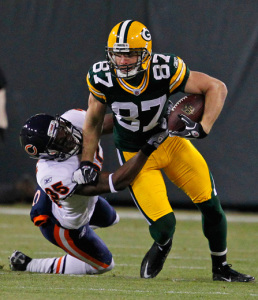
Nelson has been the league's best receiver in 2014
I have used the concept of Adjusted Catch Yards for a long time; that metric
is the base statistic in my Greatest Wide Receivers Ever post. ACY, you may recall, is simply receiving yards with a 5-yard bonus for receptions and a 20-yard bonus for touchdowns. Why a 5-yard yard bonus for catches?
We want to give receivers credit for receptions because, all else being equal, a receiver with more receptions is providing more value because he’s likely generating more first downs.
For the last 15 years, we have data on the number of first downs a receiver produces. But this summer, we added a bit of crucial information: we now know that the value of a first down is about 9 yards. As a result, Adjusted Catch Yards can be modified to be:
Receiving Yards + 9 * First Downs + 11 * Touchdowns
Why is the variable on touchdowns changed to 11? Because a touchdown is a first down; mathematically, this is the same as keeping the value of a touchdown at 20 but changing the first downs variable to be “first downs that did not result in a touchdown.”
This year, Jordy Nelson has caught 33 passes for 459 yards and 3 touchdowns, with 24 of those catches going for first downs (and, of course, 21 going for first downs and not being a touchdown). As a result, Nelson has produced 708 Adjusted Catch Yards this year. But we don’t want to just rank receivers by Adjusted Catch Yards. One thing we can do is rank them on a per-attempt basis; while not as advanced as True Receiving Yards, this provides a relatively simple metric that everyone can understand. We start with receiving yards; then we add bonuses for first downs and touchdowns, and finally we divide the level of production by team pass opportunities. [continue reading…]

